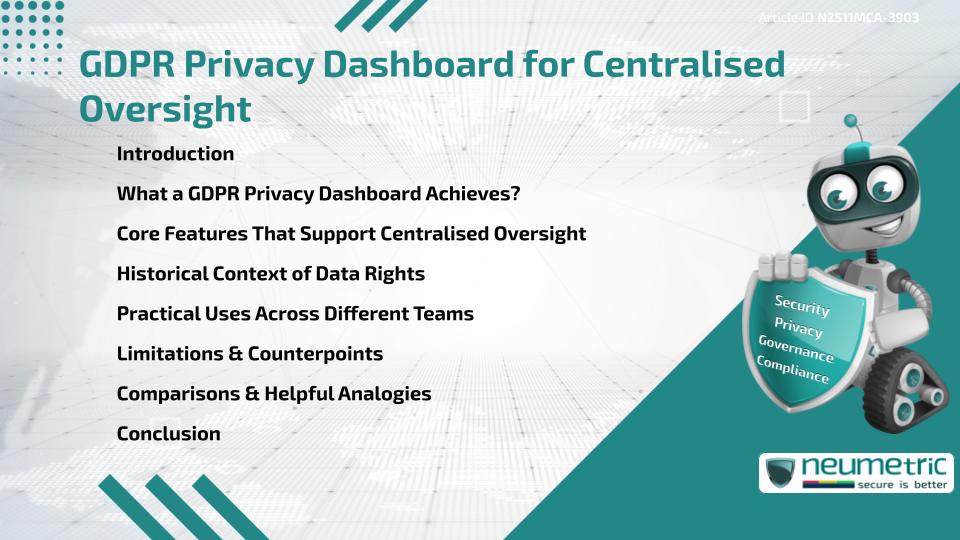Table of Contents
ToggleIntroduction
A GDPR Privacy Dashboard for centralised oversight gives organisations a single place to review data rights requests, monitor compliance tasks & understand how Personal Data flows across systems. It helps teams track lawful bases, manage retention rules & respond to Data Subjects within required timelines. This article explains how a GDPR Privacy Dashboard works, why centralised oversight matters & what features make these tools effective. It also covers the history of data rights, practical applications, comparisons, limitations & simple explanations that remove confusion.
What a GDPR Privacy Dashboard Achieves?
A GDPR Privacy Dashboard brings scattered compliance tasks into one place. Instead of jumping between inboxes, spreadsheets & ticketing tools, teams can see everything at a glance.
It helps organisations:
- Track Data Subjects rights requests
- Update records of processing
- Review retention schedules
- Monitor Risk areas
- Spot delays before an issue appears
For background, you can learn more about the General Data Protection Regulation at the official European Commission website: https://commission.europa.eu/law/law-topic/data-protection_en.
Core Features That Support Centralised Oversight
Centralised oversight depends on a few essential features. A good GDPR Privacy Dashboard usually includes:
- A simple interface that shows active rights requests
- Traffic-light indicators for overdue tasks
- A secure Audit trail
- Quick links to retention schedules
- Exportable reports
Tools like these often point users to helpful non-commercial guidance such as the Information Commissioner’s Office overview: https://ico.org.uk/for-organisations/uk-GDPR-guidance-and-resources/.
To understand why these features matter, consider the principle of accountability. Organisations must show how & why they handle Personal Data. This dashboard makes that record clear without extra manual work.
Historical Context of Data Rights
Interest in data rights is not new. Early Privacy debates shaped laws across Europe which later influenced modern rules. The GDPR Privacy Dashboard reflects these long-standing ideas by putting individuals at the centre of data handling.
A helpful reference for early Privacy debates is available at the Council of Europe Data Protection history page: https://www.coe.int/en/web/data-protection.
Practical Uses Across Different Teams
Different teams use a GDPR Privacy Dashboard for different reasons.
Compliance teams track deadlines & ensure accuracy.
Legal teams review Audit trails to confirm valid lawful bases.
IT teams check the systems that store Personal Data.
Customer service teams manage requests without chasing updates across channels.
You can read more about Data Subject Rights at the European Data Protection Board website: https://edpb.europa.eu.
Real value appears when all teams share one view. Centralised oversight reduces confusion & prevents duplicated work.
Limitations & Counterpoints
A GDPR Privacy Dashboard is helpful but not perfect.
Some critics argue that dashboards can oversimplify complex work. A colourful chart cannot always explain a legal nuance.
Larger organisations may still need manual checks for unusual cases.
Others note that dashboards depend on accurate inputs. Incorrect data still leads to incorrect conclusions.
These points show why teams must treat dashboards as guidance rather than a complete solution.
For balanced perspective, the EDRI website offers diverse commentary on data rights: https://edri.org.
Comparisons & Helpful Analogies
Think of a GDPR Privacy Dashboard like a car’s instrument panel. It does not drive the car but it shows the speed, fuel level & warnings in one place.
Without it, drivers guess their speed or wait for a breakdown.
With it, they see issues early & take action.
This is what centralised oversight achieves for Data Protection.
Another analogy is a library index. Instead of walking through every aisle to find one book, the index gives a map of where everything sits. A GDPR Privacy Dashboard provides that map for Personal Data.
Conclusion
A GDPR Privacy Dashboard for centralised oversight unifies critical compliance tasks into one accessible view. It helps organisations respond to rights requests, monitor Risks & coordinate across teams. Although it has some limitations, it remains one of the simplest ways to maintain consistent data handling practices.
Takeaways
- A GDPR Privacy Dashboard gives one place to manage compliance
- It makes oversight clear for all teams
- It increases accuracy & reduces wasted effort
- It supports accountability requirements
- It reveals issues before they escalate
FAQ
What does a GDPR Privacy Dashboard show?
It shows rights requests, retention Policies, Risks & system-level information in one place.
Why is centralised oversight important?
It avoids duplicated work & gives teams a shared source of truth.
Who uses a GDPR Privacy Dashboard?
Compliance teams, legal teams, IT teams & Customer service teams use it for different tasks.
Can a dashboard replace compliance staff?
No. It supports their work but cannot replace judgement or legal expertise.
Does it help smaller organisations?
Yes. It simplifies tasks that would otherwise be scattered across tools.
Is the information updated automatically?
Many dashboards update automatically but some require manual confirmation for accuracy.
Does it track all data across systems?
It depends on integrations. Some dashboards have broad coverage while others need extra input.
Are Audit trails included?
Most dashboards include Audit logs that show actions taken by staff.
Can it help with retention schedules?
Yes. It often includes quick views of retention rules for each category of data.
Need help for Security, Privacy, Governance & VAPT?
Neumetric provides organisations the necessary help to achieve their Cybersecurity, Compliance, Governance, Privacy, Certifications & Pentesting needs.
Organisations & Businesses, specifically those which provide SaaS & AI Solutions in the Fintech, BFSI & other regulated sectors, usually need a Cybersecurity Partner for meeting & maintaining the ongoing Security & Privacy needs & requirements of their Enterprise Clients & Privacy conscious Customers.
SOC 2, ISO 27001, ISO 42001, NIST, HIPAA, HECVAT, EU GDPR are some of the Frameworks that are served by Fusion – a SaaS, multimodular, multitenant, centralised, automated, Cybersecurity & Compliance Management system.
Neumetric also provides Expert Services for technical security which covers VAPT for Web Applications, APIs, iOS & Android Mobile Apps, Security Testing for AWS & other Cloud Environments & Cloud Infrastructure & other similar scopes.
Reach out to us by Email or filling out the Contact Form…


